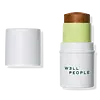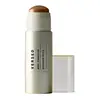What's inside
What's inside
 Key Ingredients
Key Ingredients

 Benefits
Benefits

 Concerns
Concerns

 Ingredients Side-by-side
Ingredients Side-by-side

Helianthus Annuus Seed Oil
EmollientRicinus Communis Seed Oil
MaskingMica
Cosmetic ColorantCarthamus Tinctorius Seed Oil
MaskingCopernicia Cerifera Wax
Synthetic Beeswax
Emulsion StabilisingCastor Isostearate Succinate
Skin ConditioningTocopherol
AntioxidantPolyhydroxystearic Acid
EmulsifyingCaprylic/Capric Triglyceride
MaskingSimmondsia Chinensis Seed Oil
EmollientRosa Rubiginosa Seed Oil
EmollientCrambe Abyssinica Seed Oil
Skin ConditioningIsostearic Acid
CleansingTin Oxide
AbrasiveCalendula Officinalis Flower Extract
MaskingLecithin
EmollientPolyglyceryl-3 Polyricinoleate
EmulsifyingCamellia Sinensis Seed Oil
HumectantAloe Barbadensis Leaf Juice
Skin ConditioningMaltodextrin
AbsorbentPotassium Sorbate
PreservativeSodium Benzoate
MaskingHelianthus Annuus Seed Oil, Ricinus Communis Seed Oil, Mica, Carthamus Tinctorius Seed Oil, Copernicia Cerifera Wax, Synthetic Beeswax, Castor Isostearate Succinate, Tocopherol, Polyhydroxystearic Acid, Caprylic/Capric Triglyceride, Simmondsia Chinensis Seed Oil, Rosa Rubiginosa Seed Oil, Crambe Abyssinica Seed Oil, Isostearic Acid, Tin Oxide, Calendula Officinalis Flower Extract, Lecithin, Polyglyceryl-3 Polyricinoleate, Camellia Sinensis Seed Oil, Aloe Barbadensis Leaf Juice, Maltodextrin, Potassium Sorbate, Sodium Benzoate
Coco-Caprylate/Caprate
EmollientOctyldodecanol
EmollientCaprylic/Capric Triglyceride
MaskingSilica
AbrasiveDiisostearyl Malate
EmollientHelianthus Annuus Seed Wax
Skin ConditioningC10-18 Triglycerides
EmollientPolyhydroxystearic Acid
EmulsifyingCaprylic/Capric/Myristic/Stearic Triglyceride
EmollientStearyl Behenate
EmollientDicalcium Phosphate
AbrasiveSimmondsia Chinensis Seed Oil
EmollientStearalkonium Hectorite
Gel FormingSorbitan Isostearate
EmulsifyingPolyglyceryl-2 Triisostearate
EmulsifyingIsostearic Acid
CleansingLecithin
EmollientPolyglyceryl-3 Polyricinoleate
EmulsifyingBlakeslea Trispora Mycelium Extract
Propylene Carbonate
SolventSilica Silylate
EmollientTitanium Dioxide
Cosmetic ColorantBlue 1 Lake
Cosmetic ColorantCI 77491
Cosmetic ColorantCI 77492
Cosmetic ColorantCI 77499
Cosmetic ColorantCoco-Caprylate/Caprate, Octyldodecanol, Caprylic/Capric Triglyceride, Silica, Diisostearyl Malate, Helianthus Annuus Seed Wax, C10-18 Triglycerides, Polyhydroxystearic Acid, Caprylic/Capric/Myristic/Stearic Triglyceride, Stearyl Behenate, Dicalcium Phosphate, Simmondsia Chinensis Seed Oil, Stearalkonium Hectorite, Sorbitan Isostearate, Polyglyceryl-2 Triisostearate, Isostearic Acid, Lecithin, Polyglyceryl-3 Polyricinoleate, Blakeslea Trispora Mycelium Extract, Propylene Carbonate, Silica Silylate, Titanium Dioxide, Blue 1 Lake, CI 77491, CI 77492, CI 77499
Alternatives
Ingredients Explained
These ingredients are found in both products.
Ingredients higher up in an ingredient list are typically present in a larger amount.
This ingredient is an emollient, solvent, and texture enhancer. It is considered a skin-softener by helping the skin prevent moisture loss.
It helps thicken a product's formula and makes it easier to spread by dissolving clumping compounds.
Caprylic Triglyceride is made by combining glycerin with coconut oil, forming a clear liquid.
While there is an assumption Caprylic Triglyceride can clog pores due to it being derived from coconut oil, there is no research supporting this.
Learn more about Caprylic/Capric TriglycerideIsostearic acid is a saturated fatty acid. Its structure makes it a great surfactant.
Surfactants help decrease the surface tension between two liquids. This property also makes it an effective emulsifier. Emulsifiers help prevent waters and oils from separating in a product.
Isostearic Acid is created from oleic acid.
This ingredient may not be Malassezia folliculitis, or fungal-acne safe.
Learn more about Isostearic AcidLecithin is a term for a group of substances found in the cell membranes of plants, animals, and humans. They are made up of mixture of phospholipids.
This ingredient has emollient and emulsifying properties.
As an emollient, lecithen helps soften the skin and creates a barrier to keep moisture in.
As an emulsifier, it also helps prevent water and oil ingredients from separating. Lecithin can also help ingredients be better absorbed by the skin.
This is because the phospholipids in lecithin produce liposomes. Liposomes help other ingredients get through the skin barrier.
Depending on the source of this ingredient, lecithin may not be fungal acne safe. This is because some sources of lecithin come from soybean oil, which may feed the malassezia yeast that feeds fungal acne.
We recommend reaching out to the brand you are purchasing from to inquire about the source of their lecithin.
Some other names for this ingredient include soy lecithin and deoiled soy lecithin.
Learn more about LecithinThis ingredient is an emulsifier. It is created from Polyglycerin-3 and Ricinoleic Acid.
As an emulsifier, it prevents waters and oils from separating. According to a manufacturer this ingredient is fully biodegradable.
This ingredient may not be safe for Malassezia folliculitis due to its Ricinoleic Acid base. Ricinoleic Acid is a fatty acid derived from castor oil.
Learn more about Polyglyceryl-3 PolyricinoleatePolyhydroxystearic Acid is a soft wax made from castor oil.
It is is a texture thickener, emulsifier, and film-former. Emulsifiers prevent ingredients from separating, such as oils and waters.
Polyhydroxystearic Acid may not be fungal acne safe.
Learn more about Polyhydroxystearic AcidThis oil comes from the seeds of the desert shrub called Jojoba. It is more commonly known as jojoba oil, a non-comedogenic oil.
Jojoba oil does not contain fragrance and has many fatty-acids, making it a great soothing ingredient.
It also contains Vitamin E, a great moisturizing ingredient. Vitamin E is also an antioxidant and protects your skin against oxidative damage.
This ingredient humectant properties, meaning it helps draw moisture from the air. This helps keep your skin hydrated.
While jojoba has antibacterial properties, it is only able to kill some strains of bacteria.
Studies also show it helps in wound healing. In fact, Indigenous cultures have used jojoba as a moisturizer and to help treat burns for centuries.
Fun fact: Jojoba oil similar to natural human skin sebum, so it has a great effect on dry skin. It is also promising with helping to regulate sebum production.
Due to its fatty acid content, Jojoba oil may not be fungal acne safe. We recommend speaking with a professional if you have any concerns.
Learn more about Simmondsia Chinensis Seed Oil